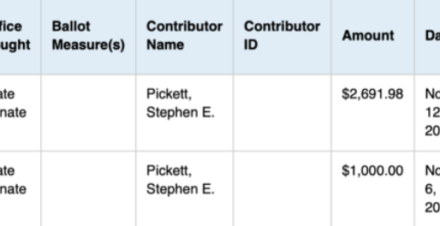We support our Publishers and Content Creators. You can view this story on their website by CLICKING HERE.
If you had told President Dwight D. Eisenhower that the military-industrial complex he famously warned against would find itself repeatedly foiled by an off-the-shelf product available at the grocery store, he probably would not have believed you.
The Oct. 12 story published in The Wall Street Journal, about how mysterious drones over Langley Air Force Base have baffled the best of America’s military and homeland security apparatus, is clearly not intended to leave you with this impression, yet it does.
The Journal article was likely intended as yet another entry in the now-extensive subgenre of Pentagon reporting that might be called, “What are we going to do about the UFOs?”
In these stories, which seem to regularly appear several times a year (possibly timed with congressional appropriations), military and intelligence officials either publicly or anonymously complain to their regular Pentagon beat journalists about how they are stumped by the mysterious lights in the sky. In 2022, the Pentagon set up the All-domain Anomaly Resolution Office (AARO) to better collect and analyze reports of these UFO sightings. Before AARO was the wordier Airborne Object Identification and Management Synchronization Group (AOIMSG), set up in 2021. Congress has had multiple UFO hearings, ranging from fairly serious investigations into the likely role of Russian and Chinese drones surveilling U.S. national security sites to “X Files”-style hearings with whistleblowers claiming the U.S. has recovered alien corpses — or, as they phrase it, “biologics.”
The Wall Street Journal piece attempted to emphasize how serious the deployment of unidentified drone swarms over U.S. military bases is and the extent to which U.S. officials were willing to go to identify and stop them. Even the president was brought in to discuss what to do about the mysterious lights in the sky over Hampton, Virginia:
Reports of the drones reached President Biden and set off two weeks of White House meetings after the drones first appeared in December last year. Officials from agencies including the Defense Department, Federal Bureau of Investigation and the Pentagon’s UFO office joined outside experts to throw out possible explanations as well as ideas about how to respond.
But reading on, one learns that the only thing these bureaucrats successfully “shot down” were the various proposals about how to deal with the problem, as each service and agency offered various approaches, ranging from simple nets to electronic warfare, none of which were adopted. Most of these approaches strike the casual reader as perfectly sensible, but all were foiled by one perceived regulation or another.
In the end, the Journal strongly implies that the drone intrusions over Langley Airforce Base came to a halt only because twenty-something Chinese student Fengyun Shi accidentally crashed his drone into a tree. Law enforcement identified Shi’s suspicious behavior, and he was arrested before he could escape on a one-way trip back to China. He was convicted of espionage and sentenced to only six months in prison.
This story provides a genuine, although probably unintentional, insight into American national security. U.S. policymakers tie themselves in knots over what they view as insurmountably complex technological and regulatory questions, instead of accepting common-sense approaches.
What if the solution to mysterious UFOs harassing U.S. military bases is as simple as not handing out millions of student visas to foreigners from hostile nations known to force their people to engage in espionage? Such a solution is unlikely to come up for consideration — partially for political reasons, but also partially because it’s just too simple.
Our national security apparatus is addicted to complexity. The more complex the problem, the more our elites feel justified in insisting that only the experts with the best credentials at the highest levels can be trusted to address the challenges we face. The larger the budgets that can be requested, the easier the excuses for when the problem remains unresolved.
The purpose of swarm tactics (whether from drones or otherwise) is to overwhelm a single target with multiple autonomous entities, which become increasingly difficult to track and react against.
The vulnerability being exploited isn’t a technological one. Rather it’s exploiting the opponent’s centralized and rigid decision-making process. This is the same logic deployed by Antifa rioters, who seek to overwhelm law enforcement with dozens of independently operating affinity groups.
Where all tactical decisions are increasingly centralized, and often subjected to political pressure (such as the role played by vice presidential candidate Gov. Tim Walz in the loss of the Third Minneapolis Police Precinct during the 2020 riots), autonomous swarm tactics win the day. Where individuals and small groups are empowered to respond as needed and cut through the red tape, swarms can be defeated, as amply demonstrated by the response from Florida police to illegal efforts by pro-Hamas protesters to blockade major roads in April 2024. Where power is centralized, the swarm wins every time.
We should be wary when the national security apparatus insists that if we just granted them additional powers, they could defeat the latest and greatest threat. We should be skeptical of claims that we must continue to centralize power so our safety can be ensured. Instead, to defeat the swarms that threaten us, we should be on the lookout for ways to decentralize our security, spreading out responsibilities and empowering those closest to the problem to react with prudence.
Kyle Shideler is senior analyst for Homeland Security at the Center for Security Policy.

 Conservative
Conservative  Search
Search Trending
Trending Current News
Current News 





